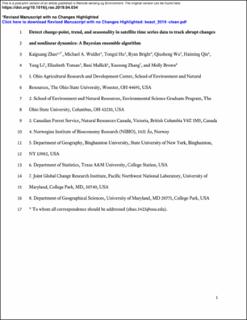| dc.contributor.author | Zhao, Kaiguang | |
| dc.contributor.author | Wulder, Michael A. | |
| dc.contributor.author | Hu, Tongxi | |
| dc.contributor.author | Bright, Ryan M. | |
| dc.contributor.author | Wu, Qiusheng | |
| dc.contributor.author | Qin, Haiming | |
| dc.contributor.author | Li, Yang | |
| dc.contributor.author | Toman, Elizabeth | |
| dc.contributor.author | Mallick, Bani | |
| dc.contributor.author | Zhang, Xuesong | |
| dc.contributor.author | Brown, Molly | |
| dc.date.accessioned | 2020-04-15T11:16:26Z | |
| dc.date.available | 2020-04-15T11:16:26Z | |
| dc.date.created | 2019-09-12T18:33:42Z | |
| dc.date.issued | 2019-10 | |
| dc.identifier.citation | Remote Sensing of Environment. 2019, 232 1-20. | en_US |
| dc.identifier.issn | 0034-4257 | |
| dc.identifier.uri | https://hdl.handle.net/11250/2651134 | |
| dc.description.abstract | Satellite time-series data are bolstering global change research, but their use to elucidate land changes and vegetation dynamics is sensitive to algorithmic choices. Different algorithms often give inconsistent or sometimes conflicting interpretations of the same data. This lack of consensus has adverse implications and can be mitigated via ensemble modeling, an algorithmic paradigm that combines many competing models rather than choosing only a single “best” model. Here we report one such time-series decomposition algorithm for deriving nonlinear ecosystem dynamics across multiple timescales—A Bayesian Estimator of Abrupt change, Seasonal change, and Trend (BEAST). As an ensemble algorithm, BEAST quantifies the relative usefulness of individual decomposition models, leveraging all the models via Bayesian model averaging. We tested it upon simulated, Landsat, and MODIS data. BEAST detected changepoints, seasonality, and trends in the data reliably; it derived realistic nonlinear trends and credible uncertainty measures (e.g., occurrence probability of changepoints over time)—some information difficult to derive by conventional single-best-model algorithms but critical for interpretation of ecosystem dynamics and detection of low-magnitude disturbances. The combination of many models enabled BEAST to alleviate model misspecification, address algorithmic uncertainty, and reduce overfitting. BEAST is generically applicable to time-series data of all kinds. It offers a new analytical option for robust changepoint detection and nonlinear trend analysis and will help exploit environmental time-series data for probing patterns and drivers of ecosystem dynamics. | en_US |
| dc.language.iso | eng | en_US |
| dc.subject | Changepoint | en_US |
| dc.subject | Bayesian changepoint detection | en_US |
| dc.subject | Disturbance ecology | en_US |
| dc.subject | Breakpoint | en_US |
| dc.subject | Trend analysis | en_US |
| dc.subject | Time series decomposition | en_US |
| dc.subject | Bayesian model averaging | en_US |
| dc.subject | Disturbances | en_US |
| dc.subject | Nonlinear dynamics | en_US |
| dc.subject | Regime shift | en_US |
| dc.subject | Ensemble modeling | en_US |
| dc.subject | Time series segmentation | en_US |
| dc.subject | Phenology | en_US |
| dc.title | Detecting change-point, trend, and seasonality in satellite time series data to track abrupt changes and nonlinear dynamics: A Bayesian ensemble algorithm | en_US |
| dc.type | Peer reviewed | en_US |
| dc.type | Journal article | en_US |
| dc.description.version | acceptedVersion | en_US |
| dc.rights.holder | © 2019 Elsevier Inc. All rights reserved. | en_US |
| dc.source.pagenumber | 1-20 | en_US |
| dc.source.volume | 232 | en_US |
| dc.source.journal | Remote Sensing of Environment | en_US |
| dc.identifier.doi | 10.1016/j.rse.2019.04.034 | |
| dc.identifier.cristin | 1724186 | |
| dc.relation.project | Andre: OWRC: 2018OH567B - USGS 104B | en_US |
| dc.relation.project | Andre: OFSLRSS201604 - Chinese Academy of Sciences | en_US |
| dc.relation.project | Andre: CRM0518513 - Microsoft Azure for Research | en_US |
| dc.relation.project | Norges forskningsråd: 250113 | en_US |
| dc.relation.project | Andre: OFSLRSS201604 - CHINESE ACADEMY OF SCIENCES | en_US |
| dc.relation.project | Andre: CRM0518513 - MICROSOFT AZURE FOR RESEARCH | en_US |
| cristin.ispublished | true | |
| cristin.fulltext | postprint | |
| cristin.qualitycode | 2 | |
